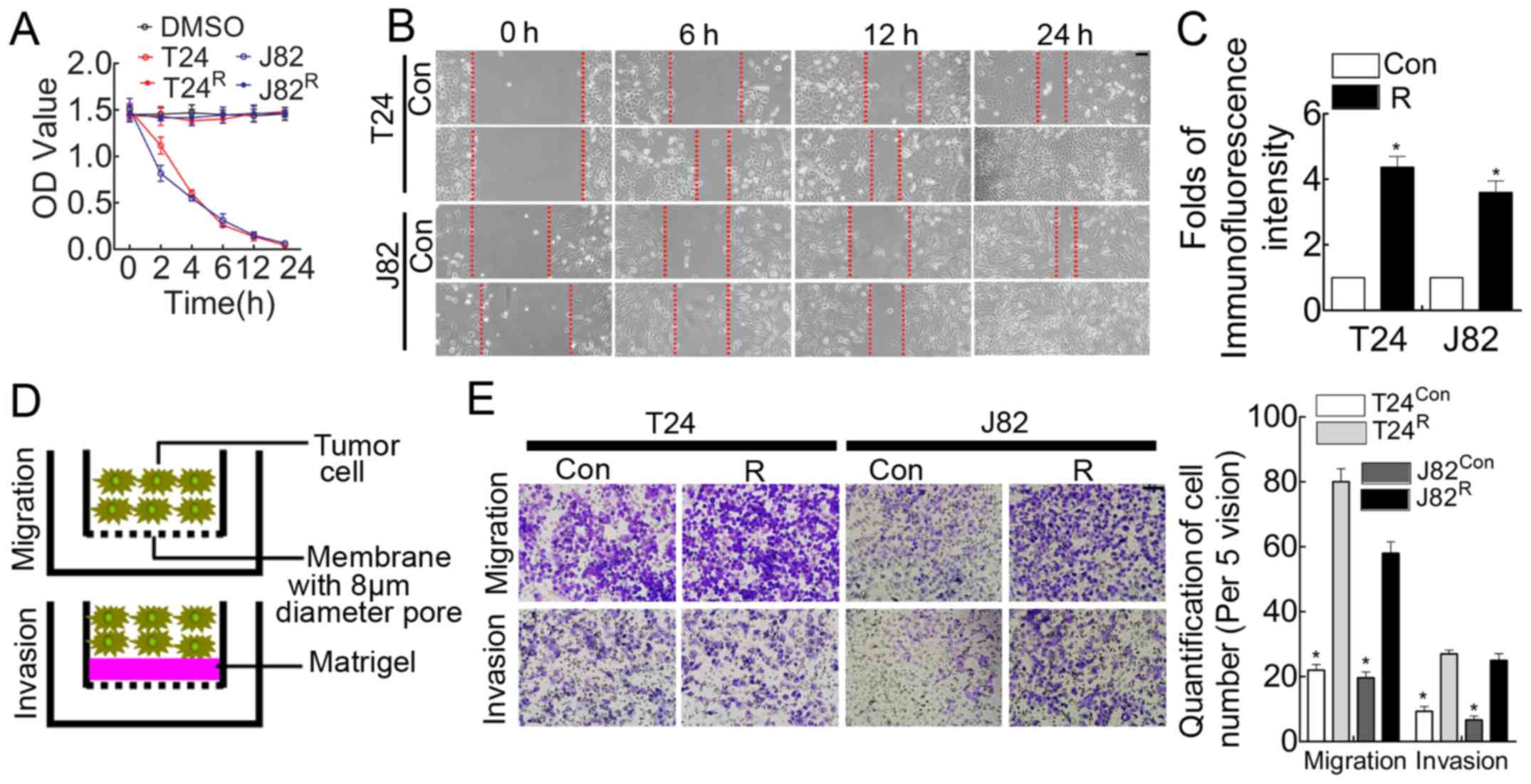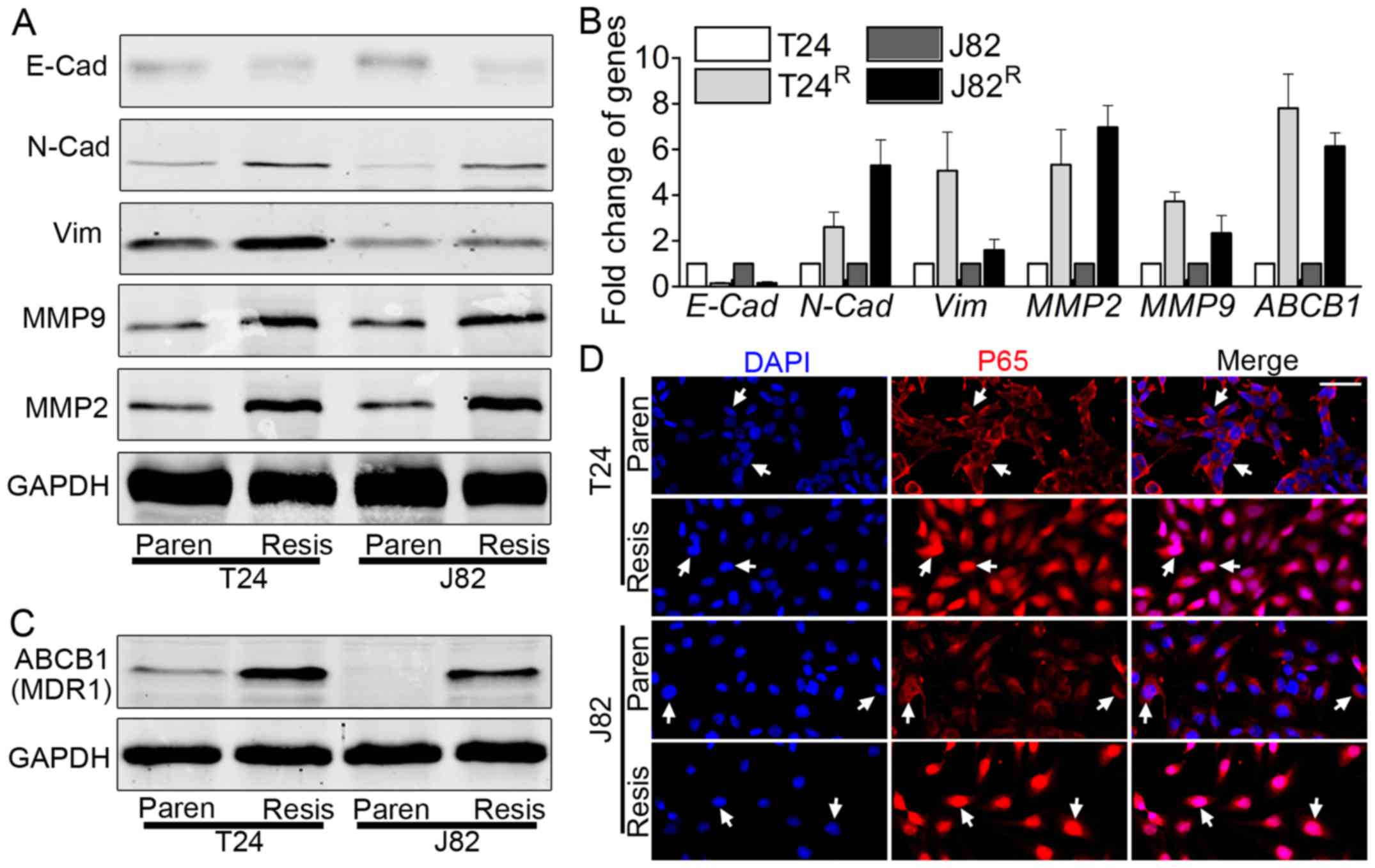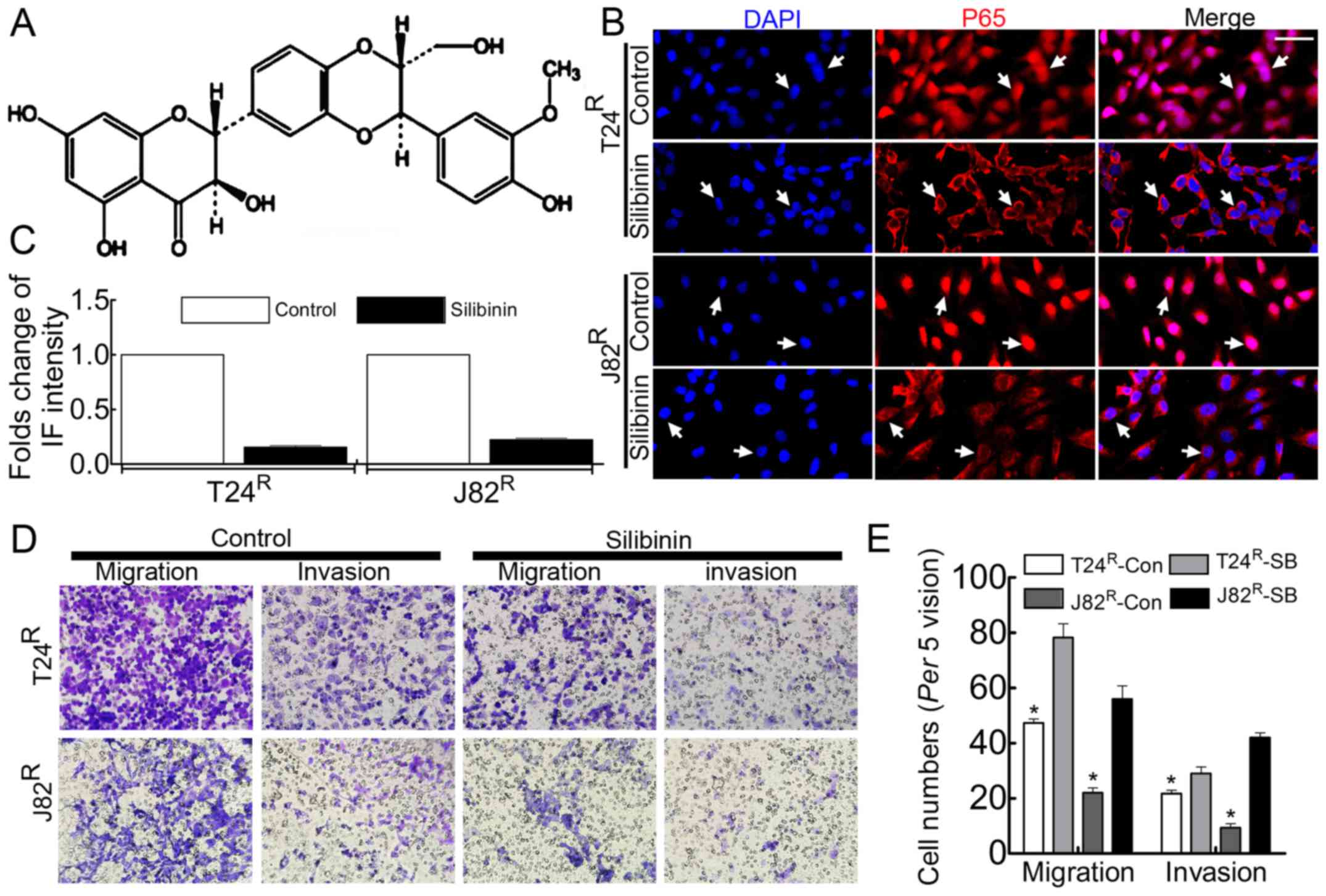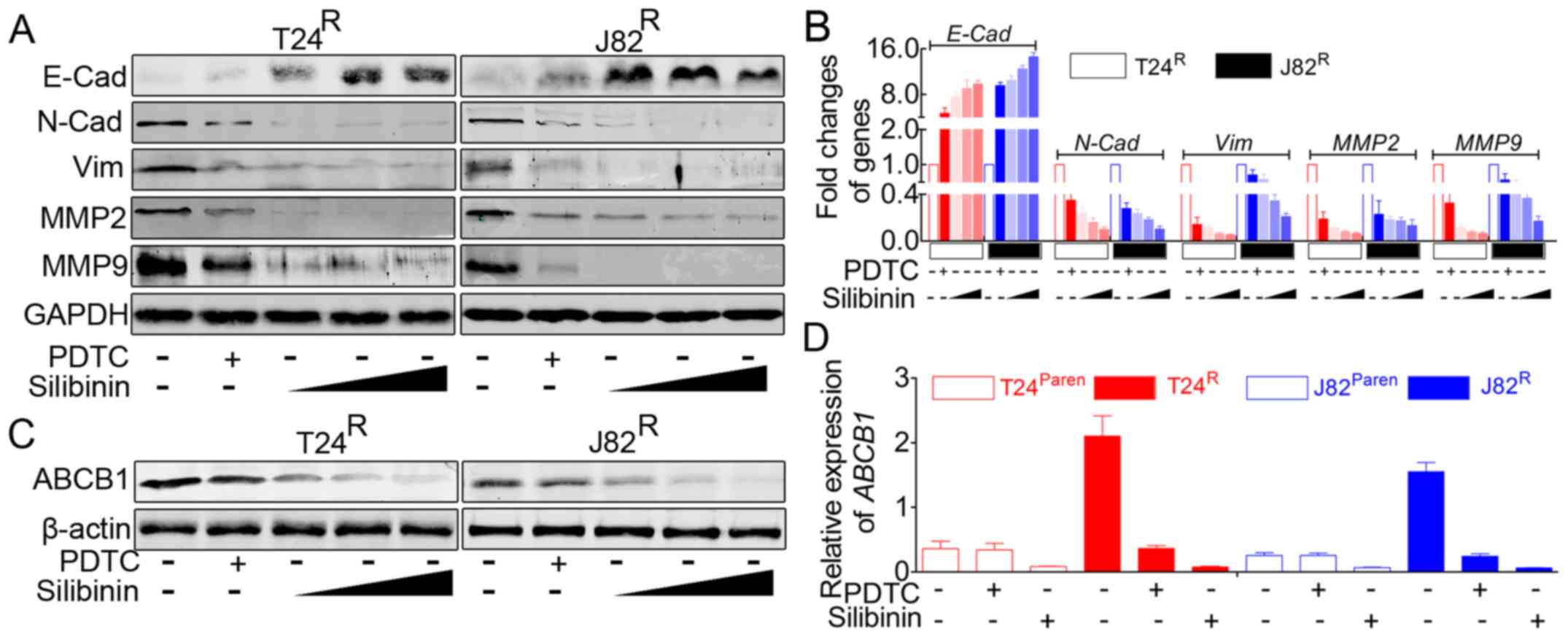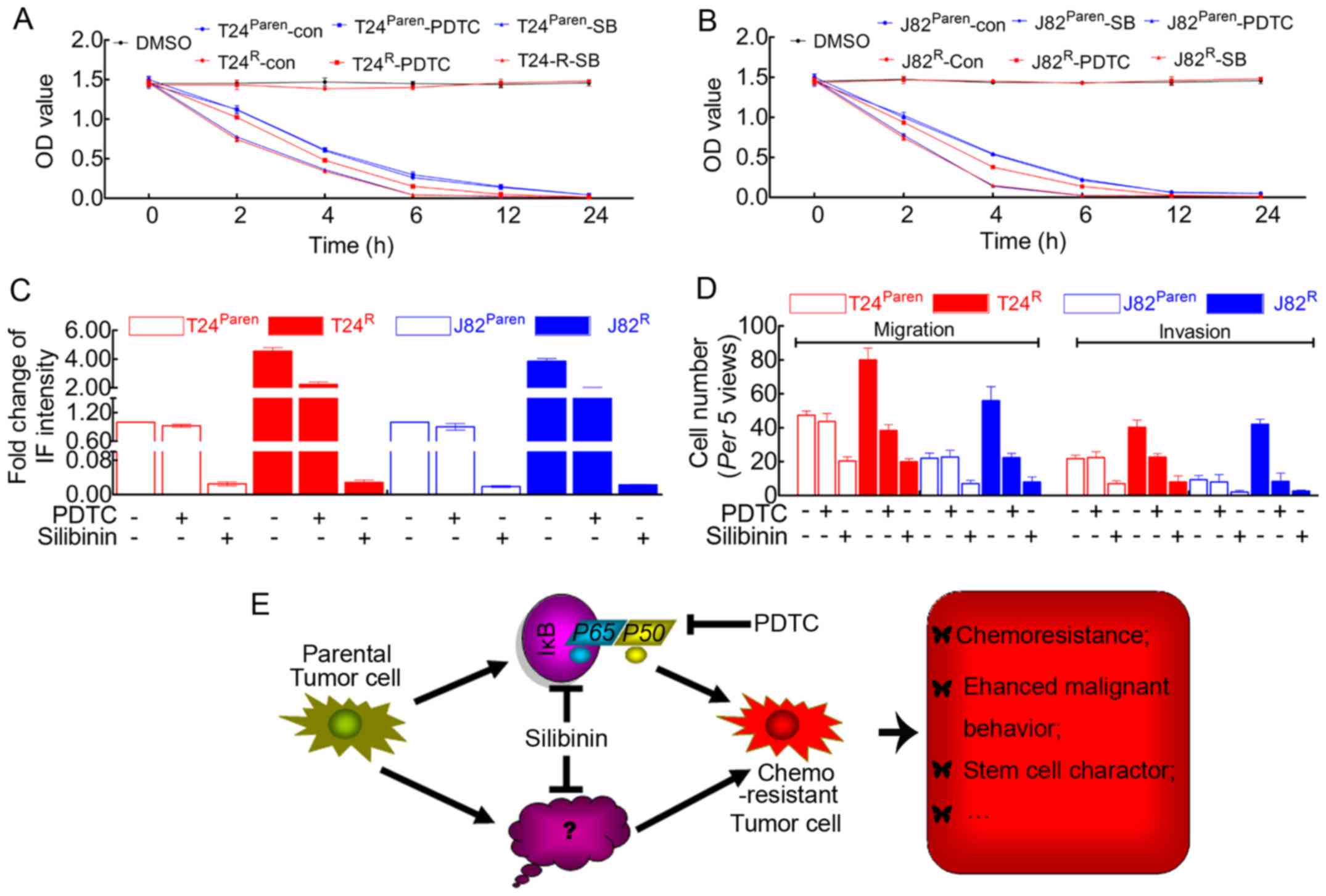Silibinin suppresses bladder cancer cell malignancy and chemoresistance in an NF-κB signal-dependent and signal-independent manner
- Authors:
- Published online on: August 2, 2017 https://doi.org/10.3892/ijo.2017.4089
- Pages: 1219-1226
Abstract
Introduction
Worldwide, bladder cancer (BCa) is the 9th most common cancer and the 13th leading cause of death due to cancer (1), and it has attracted increasing attention from clinicians over the past several decades. The risk factors for BCa include but are not limited to genetic predisposition and acquired exposure, the mechanism of which is still unclear (2–5). Clinically, according to the pathological characteristics, BCa includes superficial and invasive types, which are treated using different therapeutic procedures. Briefly, the recommended therapeutic guideline for superficial BCa is transurethral resection of bladder tumor (TUR-bt), followed by intravesical chemo- or immunotherapeutics. Unfortunately, 70% of superficial BCa will inevitably progress to the invasive type followed by enhanced tumor malignancy. For invasive BCa, cystectomy plus adjuvant or neoadjuvant chemotherapy is accepted by clinicians and patients (6). Thus, chemotherapy is a vital and irreplaceable regimen for treating invasive BCa, regardless of whether initial invasive BCa or invasive BCa progressed from the superficial type. Many studies have indicated that cisplatin-based regimens play effective roles in BCa therapy (7,8). However, chemoresistance to cisplatin-containing regimens inevitably appears in the battle against BCa, the mechanism of which is still unknown.
Previous reports have identified the important roles of NF-κB signaling in the initiation and progression of BCa, e.g., promoting the process of epithelial to mesenchymal transition (EMT) (9), secreting MMP2/MMP9 and inhibiting apoptosis. In addition, the promoter of MDR1 (ABCB1), a multiple drug-resistant gene, contains an NF-κB binding site, indicating that MDR1 was monitored by this signaling pathway (10).
Silibinin, a polyphenolic flavonoid component isolated from the fruits or seeds of milk thistle (Silybum marianum), has been clinically used to treat various diseases, and it has been suggested that this reagent exhibited protective effects for patients with liver or heart disease. The inhibitory effects of silibinin against cancer were also indicated (11–17) in tumors such as breast cancer and head and neck squamous cell carcinomas. Our previous study indicated that silibinin inhibited BCa progression (18), leading us to hypothesize a link between silibinin and BCa chemoresistance.
In the present study, we hypothesized that silibinin may play inhibitory roles in the chemoresistance of BCa cells, possibly involving the NF-κB signaling pathway. Our results revealed that silibinin inhibited the progression and reversed the chemoresistance of BCa cells in an NF-κB-dependent and -independent manner, thus providing a potential therapeutic use for silibinin in patients with BCa.
Materials and methods
Cell culture
Human BCa cell lines T24 and J82 were obtained from the ATCC (American Type Culture Collection, Manassas, VA, USA) and cultured in DMEM supplemented by 10% FBS (Invitrogen, Carlsbad, CA, USA). Cells were cultured in incubators (Thermo Scientific, Germany) in an atmosphere with 5% CO2 at 37°C.
To obtain stable, cisplatin-resistant cell lines, we monitored the IC50 of cisplatin and obtained values of 58 µM for T24 and 49 µM for J82. Second, the cisplatin-resistant index (RI) was evaluated by MTT; the RIs of the cell lines were 21.35 and 28.75 for T24 and J82, respectively. The cultured parental T24 and J82 cells were supplemented with 20 µM cisplatin. The medium was refreshed every two days to remove the dead cells, and the cells were washed three times with sterile PBS (pH 7.2). This treatment was administered for more than three months to obtain stable cisplatin-resistant T24/J82 cells (tagged with T24R/J82R).
To inhibit NF-κB signaling, pyrrolidine dithiocarbamate (PDTC) (Sigma-Aldrich, USA) (19), an inhibitor of the NF-κB pathway, was used; the final concentration was 10 µM in the medium for the last 24 h before analysis.
Wound healing assay
Wound healing assays were carried out by scratching a 6-well dish with a 10-µl pipette tip when the dish was at 80% confluence (including parental cell and cisplatin-resistant cell lines). The width of the scratches was compared at 0, 6, 12 and 24 h after scratching.
Western blot analysis
Pretreated cells were harvested at 80% confluency and washed three times with cold PBS. Total cellular protein lysates were prepared with RIPA buffer [50 mM Tris (pH 8.0), 150 mM NaCl, 0.1% SDS, 1% NP40 and 0.5% sodium deoxycholate] containing proteinase inhibitors [1% inhibitor cocktail and 1 mM PMSF, both from Sigma, (St. Louis, MO, USA)]. Then, 30 µg of protein was separated on 10% SDS-PAGE gels and transferred to nitrocellulose membranes. The membranes were blocked at room temperature for 1 h with 5% skim milk in Tris-buffered saline (pH 7.6, TBS). Polyclonal primary antibodies were applied at different dilutions (Table I) in 5% skim milk in TBS at 4°C overnight, followed by TBST (with Tween-20) washes. Membranes were incubated with fluorescent secondary antibodies (LI-COR, Rockford, IL, USA) coupled to the first antibody at room temperature in the dark for 1 h, then washed with TBST, dried with neutral absorbent paper and scanned with the Odyssey Detection system (lI-COR). MG-132 (Sigma-Aldrich) was used to inhibit the proteasome-dependent degradation when necessary (10 µM, 4 h before the protein harvest). GAPDH was used as a loading control (for total cell fraction).
Real-time PCR
Cellular total RNA was isolated using TRIzol reagent (Invitrogen) and quantified by absorbance at 260 nm. RNA (2 µg) was reverse transcribed using Revert Aid™ First Strand cDNA Synthesis kit (MBI Fermentas, St. Leon-Rot, Germany) strictly according to the manufacturer's protocol. For real-time PCR, we used the SYBR Premix Ex Taq™ II system (Takara Biotechnology Co., ltd., Dalian, China) and the Bio-Rad CFX96TM Real-time system (Bio-Rad, CA, USA). Primers are listed in Table II. Briefly, 12.5 µl of SYBR Premix Ex Taq II, 1 µl of primer (F and R, respectively), 200 ng of cDNA and 9.5 µl of distilled and deionized water were mixed together, followed by two-stage, pre-denaturation at 95°C, 30 sec, one repeat; and PCR reaction, at 95°C, 5 sec followed by 60°C, 30 sec, 30 repeats; and the third stage as dissociation, 95°C, 15 sec followed by 60°C, 30 sec, and another 95°C, 15 sec. GAPDH was used as the loading control.
Cell viability assay (MTT assay)
Cell viability was assessed using a tetrazolium-based assay. Pretreated cells were incubated in the absence or presence of cisplatin/doxorubicin for the indicated times, and then washed once with PBS and incubated with 0.5 mg/ml of MTT at 37°C for 1 h. The reagent was reduced by living cells to form an insoluble blue formazan product. After incubation, cells were lysed with DMSO. Colorimetric analysis using a 96-well microplate reader was performed at a wavelength of 490 nm. The experiments were performed in triplicate.
Cell migration/invasion assay
Migration/invasion ability was demonstrated by Boyden chamber assay. Chambers with 8-µm-diameter pores were obtained from Millipore (Millipore, Switzerland). For the migration assay, 0.2 ml of FBS-free DMEM medium suspension with 10,000 cells was added to the upper chamber in a 24-well plate, and 0.8 ml of FBS-free DMEM was added to the lower chamber. After 12 h of incubation, the chambers were washed with PBS (pH 7.4) three times to remove the cells in the upper chamber, fixed with 4% formalin for 15 min, and then stained with crystal violet (0.01% in ethanol) for 25 min followed by washing three times with PBS. The cells were counted using an inverted microscope, five images were randomly taken at 200× magnification, and the average number of cells was analyzed. For the invasion assay, the cell suspension (10,000 cells/well) in the upper chamber contained 0.2 ml mixture of FBS-free DMEM/Matrigel at an 8/1 ratio (Matrigel, Sigma, USA). Cells were incubated for 36 h, and the remainder of the protocol was conducted in a similar manner to the migration assay.
Cell proliferative capacity assay
A 5-bromo-2-deoxyuridine (BrdU) incorporation assay was used to analyze tumor proliferative ability. Briefly, pretreated cells were plated on 8-well glass plates (Millipore) until 50–70% confluency. BrdU was added to the medium (3 µg/ml), followed by 4 h of incubation and rinsing 3X with PBS over 10 min to remove residual free BrdU. Cells were then fixed with 4% paraformaldehyde for 45 min, followed by rinsing 5X with PBS over 20 min. Then, 0.1% Triton X-100 was used to permeabilize the cell membrane for 15 min, and 2 N HCl was added for 25 min to separate DNA into single strands and thus allowing primary antibody access to the incorporated BrdU. Cells were then rinsed 3X with PBS over 10 min, and non-specific epitopes were blocked by 10% BSA for 20 min. Anti-BrdU antibody (1:200) in 10% BSA was added and incubated overnight at 4°C. Cells were rinsed 5X with PBS, followed by incubation with TRITC-labeled secondary antibody for 1 h at room temperature, and finally rinsed 3X with PBS to remove the free antibody. The fluorescence intensity of TRITC was monitored with a SuperMicro Orifice Plate spectrophotometer (BioTek, USA) at 547 nm.
Immunofluorescence staining for nuclear translocation of NF-κB
After the designated treatment, the pretreated cells were washed three times with cold PBS (pH 7.4), followed by fixing with 4% paraformaldehyde for 15 min, permeabilization in 0.5% Triton X-100 for 10 min, and incubation in 1% BSA blocking solution for 1 h. Fixed cells were incubated overnight at 4°C with rabbit anti-human-P65 in 1% BSA. Cells were washed and incubated with mouse anti-rabbit TRITC (Red) IgG antibody (Santa Cruz Biotechnology, USA) diluted 1:100 in blocking buffer for 1 h. Nuclei were stained with DAPI for 5 min. Cells were examined with a fluorescence microscope equipped with narrow bandpass excitation filters to individually select for red and blue fluorescence. Cells were observed through the Image-Pro Plus system™ mounted on a fluorescent microscope (Olympus, Japan). Each experiment was repeated three times.
Statistical analysis
ANOVA test was used to analyze the statistical discrepancy in >3 groups. Student's t-test was used to detect any statistically significant difference between 2 groups. P-values <0.05 were considered significant.
Results
Stable chemoresistant cell lines induced by cisplatin manifest enhanced migration/invasion and proliferation capacity
Chemoresistance is considered a vital obstacle in the battle against BCa and leads to the failure of BCa chemotherapy (20). Cisplatin, which is one of the major reagents in the chemotherapeutic regime for BCa, is recommended as first-line treatment in the clinic (21). Therefore, cisplatin resistance is ubiquitous in BCa patients, and dissecting the underlying mechanism potentially brings benefits to BCa patients. Cisplatin was used to treat BCa cell lines T24/J82 to obtain stable cisplatin-resistant cell lines (tagged by T24R and J82R, respectively), as indicated in the Materials and methods. Compared with parental T24/J82, T24R/J82R manifested cisplatin-resistance demonstrated by MTT assay (Fig. 1A). In addition, the in vitro analysis suggested that the wound-healing time was shorter for these cisplatin-resistant BCa cells (Fig. 1B), accompanied by enhanced proliferation (Fig. 1C) and migration/invasion (Fig. 1E) ability.
EMT markers are induced in T24R/J82R cells, accompanied by elevated expression of ABCB1 (MDR1)
The enhanced capacity of migration/invasion and proliferation of T24R/J82R prompted us to monitor the expression of related genes, including EMT markers and matrix metalloproteinase (MMP). Both western blot analysis (Fig. 2A) and real-time PCR (Fig. 2B) indicated the elevated expression of EMT-related markers, e.g., N-cadherin, vimentin, MMP2 and MMP9, with decreased expression of E-cadherin. ABCB1, also called MDR1, plays a vital role in BCa chemoresistance (20). Therefore, the expression of ABCB1 was monitored in T24R/J82R by western blot analysis and real-time PCR. ABCB1 was elevated in T24R/J82R vs. T24/J82, as shown by blot analysis (Fig. 2C) and real-time PCR (Fig. 2B).
NF-κB signaling is overactivated in T24R/J82R
Emerging evidence noted the importance of NF-κB signaling in tumorigenesis and cancer metastasis (22,23), as well as chemoresistance (24), leading us to link the cisplatin-induced phenomenon to this signaling pathway. As indicated in Fig. 2D, immunofluorescence staining suggested that T24R/J82R cells significantly manifested P65 nuclear translocation, suggesting the activation of this signaling pathway. In a parallel experiment, nuclear lysates from T24R/J82R indicated the accumulation of P65 in nuclei, as demonstrated by blot analysis (data not shown). Thus, we concluded that NF-κB signaling was overactivated in T24R/J82R cells vs. parental T24/J82 cells.
Migration/invasion ability and proliferation of T24R/J82R are attenuated in the present of silibinin, accompanied by inhibition of NF-κB signaling in T24R/J82R cells
Silibinin has been used clinically to treat various liver diseases and has been marketed as a dietary supplement (25). Previous studies had noted that silibinin inhibited tumor growth by suppressing MMPs (26,27), VEGF, HIF-1α (25) and the process of EMT (28,29). In the present study, silibinin was used to treat BCa cell T24R/J82R, followed by Boyden chamber assay, BrdU incorporation and immunofluorescence staining to observe the malignant behavior. As expected, the enhanced proliferation capacity of T24R/J82R cells was attenuated in the presence of 100 µM silibinin (Fig. 3B), accompanied by decreased migration/invasion ability (Fig. 3C and E). In addition, the nuclear translocation of NF-κB was significantly inhibited in the presence of silibinin in T24R/J82R cells (Fig. 3D).
Silibinin suppresses the migration/invasion and proliferation capacity of T24R/J82R cells by inhibiting the expression of EMT-related markers and ABCB1 in a dose-dependent manner
Previous results suggested that silibinin could inhibit cisplatin-induced migration/invasion and proliferation. In addition, immunofluorescence staining indicated that silibinin could inhibit the activity of the NF-κB signaling pathway. According to the previous studies, this phenomenon was accompanied by an alteration of related genes and might be involved in a related signaling pathway. Therefore, we monitored the expression of EMT-related markers and ABCB1 in the presence of silibinin. As indicated in Fig. 4A and B, silibinin treatment led to significant inhibition of EMT, e.g., decreased expression of vimentin, N-cadherin, MMP2, and MMP9, with increased E-cadherin expression. In addition, silibinin suppressed the expression of ABCB1 in T24R/J82R (Fig. 4C and D). As indicated in Fig. 4, the effects of silibinin on T24R/J82R manifested in a dose-dependent manner, at doses from 100 µM, 200 µM to 400 µM, but revealed the most powerful role of PDTC.
Forced inhibition of NF-κB signaling in T24R/J82R also leads to decreased expression of EMT-related markers and ABCB1
Previous reports indicated that forced inhibition of NF-κB signaling in BCa cells resulted in the reversal of EMT (30). Herein, in parallel, we used a specific inhibitor of NF-κB signal to repeat this process. In accordance with previous reports, our data indicated that PDTC effectively attenuated the activation of NF-κB signaling (data not shown), accompanied by decreased expression of EMT-related markers (Fig. 4A and B). In addition, as mentioned above, ABCB1 was one of the target genes of NF-κB signaling, and inhibiting this pathway led to the decreased expression of ABCB1 (Fig. 4C and D).
The suppressive roles of silibinin on T24R/J82R cells presented NF-κB-dependent and -independent mechanisms
The previous results suggested that silibinin manifested more powerful inhibitory roles on T24R/J82R cells than on parental T24/J82 cells. Moreover, as stated above, NF-κB signaling was inactivated in parental T24/J82 cells, suggesting that PDTC had no visible inhibitory roles on the malignancy and proliferative capacity of parental T24/J82 cells. This led us to ask whether the inhibitory roles of silibinin on T24R/J82R involved NF-κB signaling or whether they were unrelated phenomena. Our results suggested that in T24R/J82R cells, silibinin had a stronger inhibitory role than did PDTC in the tumor cell expression of EMT markers (Fig. 4A and B), ABCB1 (Fig. 4C), cisplatin sensitivity (Fig. 5A and B), proliferation capacity (Fig. 5C) and migration/invasion capacity (Fig. 5D), suggesting that the inhibitory roles of silibinin were partially independent of NF-κB signaling. Combined with the NF-κB signal inhibition induced by silibinin, we concluded that silibinin suppressed BCa cell line T24R/J82R in an NF-κB-dependent and -independent manner.
Forced inhibition of NF-κB signaling has no visible inhibitory roles on parental T24/J82 cells
Our data indicated that inhibition of NF-κB signaling by PDTC in T24R/J82R cells led to the attenuation of malignancy and reversal of EMT. In contrast, NF-κB signaling was suppressed in parental T24/J82 cells. In parallel, as indicated in Fig. 5C and D, PDTC had no visible effect on the migration/invasion and proliferation of parental T24/J82.
Discussion
Chemoresistance, especially acquired chemoresistance, is considered a vital obstacle in the battle against cancer and can lead to the failure of cancer therapy (20,31). Chemotherapy, in accordance with radiotherapy, is the final regimen for BCa patients. In addition, in both neoadjuvant chemotherapy and traditional chemotherapy for BCa, cisplatin is the one irreplaceable reagent. Thus, cisplatin resistance ubiquitously appears in BCa patients receiving chemotherapy, which is why it is important to investigate this mechanism further as done in recent decades. To dissect this mechanism, the present study was performed.
First, we used cisplatin treatment to obtain chemoresistant cell lines as described in the Materials and methods. Our results suggested that we efficiently obtained the stable cisplatin-resistant cell lines T24R/J82R (Fig. 1A). In addition, in accordance with our hypothesis, these T24R/J82R cells manifested enhanced wound healing (Fig. 1B), proliferation (Fig. 1C) and migration/invasion (Fig. 1E) capacity. NF-κB signaling was activated in these T24R/J82R cells (Fig. 2B), accompanied by the process of EMT (Fig. 2A) and elevated expression of ABCB1 (Fig. 1C). Although our unpublished data partially revealed the mechanism responsible for cisplatin-induced chemoresistance, much work remains to be done.
Silibinin, a polyphenolic flavonoid component isolated from the fruits or seeds of milk thistle (Silybum marianum), has been clinically used to treat various liver diseases and has been marketed as a dietary supplement (32). Our previous results indicate that silibinin suppressed BCa by acting on tumor cell mitochondria (18) or another mechanism (33). Therefore, we hypothesized that silibinin might play important roles in the process of EMT, which has been previously reported in other tumors (28,29). Our results indicate that silibinin significantly suppresses the nuclear translocation of NF-κB, inhibiting NF-κB signaling (Fig. 3D). In accordance with our hypothesis, this inhibition is accompanied by an attenuated proliferation capacity (Fig. 3B) and migration/invasion capacity (Fig. 3C and E) and the reversal of EMT (Fig. 4A and B). The process by which silibinin inhibits the NF-κB signal is still unknown, but this result indicates that silibinin can potentially be used in BCa therapy.
As indicated by our data, silibinin inhibits the malignancy of BCa cells in a dose-dependent manner, e.g., the concentration of silibinin ranged from 100 to 400 µM, accompanied by decreased expression of EMT-related markers and ABCB1 (Fig. 4). Silibinin protects against heart disease in older patients and is used as a key ingredient in a Chinese herbal formula for managing age-related disease, which is also effective in a dose-dependent manner. Thus, silibinin is suitable for older BCa patients, especially those with heart disease.
Compared with PDTC, which is a specific inhibitor of NF-κB signaling, silibinin manifests more powerful inhibitory roles that affect BCa cells, especially parental T24/J82 cells (Figs. 4D and 5A–D). This indicates that the inhibitory roles of silibinin acting upon parental BCa cells might be independent of NF-κB signaling, with silibinin inhibiting the malignancy of BCa cells in a more ubiquitous manner. Taken together, these results lead us to conclude that silibinin suppresses BCa cell malignancy in an NF-κB-dependent and -independent manner.
In conclusion, as indicated in Fig. 5E, cisplatin treatment activates the NF-κB signaling pathway in an unknown manner, leading to the enhanced malignancy of BCa cells, which can be inhibited by PDTC. However, silibinin inhibited BCa progression not only by suppressing NF-κB signaling but also via other mechanisms, resulting in an enhanced therapeutic effect for BCa patients. Although the exact mechanisms are still unknown, silibinin exhibits numerous benefits and could be incorporated into various forms of therapy for BCa patients.
Acknowledgments
This study was supported in part by Overall Innovation Projects of Scientific and Technological Resources of Shaanxi Province (no. 2013KTCl03-04 to Yonggang Xu) and the National Natural Science Foundation of China (NSFC no. 81172436 to Sun Yi).
References
|
Skeldon SC and Larry Goldenberg S: Bladder cancer: A portal into men's health. Urol Oncol. 33:40–44. 2015. View Article : Google Scholar | |
|
Malats N and Real FX: Epidemiology of bladder cancer. Hematol Oncol Clin North Am. 29:177–189. vii2015. View Article : Google Scholar : PubMed/NCBI | |
|
Pang KH and Catto JWF: Bladder cancer. Surgery. 31:523–529. 2013. | |
|
Turo R, Cross W and Whelan P: Bladder cancer. Medicine. 40:14–19. 2012. View Article : Google Scholar | |
|
Kaufman DS, Shipley WU and Feldman AS: Bladder cancer. Lancet. 374:239–249. 2009. View Article : Google Scholar : PubMed/NCBI | |
|
Bellmunt J, Orsola A, Leow JJ, Wiegel T, De Santis M and Horwich A: Bladder cancer: ESMO Practice Guidelines for diagnosis, treatment and follow-up. Ann Oncol. 25(Suppl 3): iii40–iii48. 2014. View Article : Google Scholar : PubMed/NCBI | |
|
Sternberg CN, Bellmunt J, Sonpavde G, Siefker-Radtke AO, Stadler WM, Bajorin DF, Dreicer R, George DJ, Milowsky MI, Theodorescu D, et al International Consultation on Urologic Disease-European Association of Urology Consultation on Bladder Cancer 2012: ICUD-EAU International Consultation on Bladder Cancer 2012: Chemotherapy for urothelial carcinoma -neoadjuvant and adjuvant settings. Eur Urol. 63:58–66. 2013. View Article : Google Scholar | |
|
Neoadjuvant chemotherapy in invasive bladder cancer: Update of a systematic review and meta-analysis of individual patient data advanced bladder cancer (ABC) meta-analysis collaboration. Eur Urol. 48:202–205; discussion 205–206. 2005. View Article : Google Scholar : PubMed/NCBI | |
|
Julien S, Puig I, Caretti E, Bonaventure J, Nelles L, van Roy F, Dargemont C, de Herreros AG, Bellacosa A and Larue L: Activation of NF-kappaB by Akt upregulates Snail expression and induces epithelium mesenchyme transition. Oncogene. 26:7445–7456. 2007. View Article : Google Scholar : PubMed/NCBI | |
|
Saxena M, Stephens MA, Pathak H and Rangarajan A: Transcription factors that mediate epithelial-mesenchymal transition lead to multidrug resistance by upregulating ABC transporters. Cell Death Dis. 2:e1792011. View Article : Google Scholar : PubMed/NCBI | |
|
Kumar R, Deep G and Agarwal R: An overview of ultraviolet B radiation-induced skin cancer chemoprevention by silibinin. Curr Pharmacol Rep. 1:206–215. 2015. View Article : Google Scholar : PubMed/NCBI | |
|
Li F, Ma Z, Guan Z, Chen Y, Wu K, Guo P, Wang X, He D and Zeng J: Autophagy induction by silibinin positively contributes to its anti-metastatic capacity via AMPK/mTOR pathway in renal cell carcinoma. Int J Mol Sci. 16:8415–8429. 2015. View Article : Google Scholar : PubMed/NCBI | |
|
Gu HR, Park SC, Choi SJ, Lee JC, Kim YC, Han CJ, Kim J, Yang KY, Kim YJ, Noh GY, et al: Combined treatment with silibinin and either sorafenib or gefitinib enhances their growth-inhibiting effects in hepatocellular carcinoma cells. Clin Mol Hepatol. 21:49–59. 2015. View Article : Google Scholar : PubMed/NCBI | |
|
Pirouzpanah MB, Sabzichi M, Pirouzpanah S, Chavoshi H and Samadi N: Silibilin-induces apoptosis in breast cancer cells by modulating p53, p21, Bak and Bcl-XL pathways. Asian Pac J Cancer Prev. 16:2087–2092. 2015. View Article : Google Scholar : PubMed/NCBI | |
|
Bosch-Barrera J and Menendez JA: Silibinin and STAT3: A natural way of targeting transcription factors for cancer therapy. Cancer Treat Rev. 41:540–546. 2015. View Article : Google Scholar : PubMed/NCBI | |
|
Prajapati V, Kale RK and Singh RP: Silibinin combination with arsenic strongly inhibits survival and invasiveness of human prostate carcinoma cells. Nutr Cancer. 67:647–658. 2015. View Article : Google Scholar : PubMed/NCBI | |
|
Jiang K, Wang W, Jin X, Wang Z, Ji Z and Meng G: Silibinin, a natural flavonoid, induces autophagy via ROS-dependent mitochondrial dysfunction and loss of ATP involving BNIP3 in human MCF7 breast cancer cells. Oncol Rep. 33:2711–2718. 2015. View Article : Google Scholar : PubMed/NCBI | |
|
Zeng J, Sun Y, Wu K, Li L, Zhang G, Yang Z, Wang Z, Zhang D, Xue Y, Chen Y, et al: Chemopreventive and chemotherapeutic effects of intravesical silibinin against bladder cancer by acting on mitochondria. Mol Cancer Ther. 10:104–116. 2011. View Article : Google Scholar : PubMed/NCBI | |
|
Hayakawa M, Miyashita H, Sakamoto I, Kitagawa M, Tanaka H, Yasuda H, Karin M and Kikugawa K: Evidence that reactive oxygen species do not mediate NF-kappaB activation. EMBO J. 22:3356–3366. 2003. View Article : Google Scholar : PubMed/NCBI | |
|
Housman G, Byler S, Heerboth S, Lapinska K, Longacre M, Snyder N and Sarkar S: Drug resistance in cancer: An overview. Cancers (Basel). 6:1769–1792. 2014. View Article : Google Scholar | |
|
Herr HW, Dotan Z, Donat SM and Bajorin DF: Defining optimal therapy for muscle invasive bladder cancer. J Urol. 177:437–443. 2007. View Article : Google Scholar : PubMed/NCBI | |
|
Li F, Zhang J, Arfuso F, Chinnathambi A, Zayed ME, Alharbi SA, Kumar AP, Ahn KS and Sethi G: NF-κB in cancer therapy. Arch Toxicol. 89:711–731. 2015. View Article : Google Scholar : PubMed/NCBI | |
|
Gilmore TD and Wolenski FS: NF-κB: Where did it come from and why? Immunol Rev. 246:14–35. 2012. View Article : Google Scholar : PubMed/NCBI | |
|
Sui H, Zhu L, Deng W and Li Q: Epithelial-mesenchymal transition and drug resistance: Role, molecular mechanisms, and therapeutic strategies. Oncol Res Treat. 37:584–589. 2014. View Article : Google Scholar : PubMed/NCBI | |
|
Jung HJ, Park JW, Lee JS, Lee SR, Jang BC, Suh SI, Suh MH and Baek WK: Silibinin inhibits expression of HIF-1α through suppression of protein translation in prostate cancer cells. Biochem Biophys Res Commun. 390:71–76. 2009. View Article : Google Scholar : PubMed/NCBI | |
|
Kim S, Choi JH, Lim HI, Lee SK, Kim WW, Kim JS, Kim JH, Choe JH, Yang JH, Nam SJ, et al: Silibinin prevents TPA-induced MMP-9 expression and VEGF secretion by inactivation of the Raf/MEK/ERK pathway in MCF-7 human breast cancer cells. Phytomedicine. 6:573–580. 2009. View Article : Google Scholar | |
|
Kim S, Kim SH, Hur SM, Lee SK, Kim WW, Kim JS, Kim JH, Choe JH, Nam SJ, Lee JE, et al: Silibinin prevents TPA-induced MMP-9 expression by down-regulation of COX-2 in human breast cancer cells. J Ethnopharmacol. 126:252–257. 2009. View Article : Google Scholar : PubMed/NCBI | |
|
Wu K, Zeng J, Li L, Fan J, Zhang D, Xue Y, Zhu G, Yang L, Wang X and He D: Silibinin reverses epithelial-to-mesenchymal transition in metastatic prostate cancer cells by targeting transcription factors. Oncol Rep. 23:1545–1552. 2010.PubMed/NCBI | |
|
Cufí S, Bonavia R, Vazquez-Martin A, Oliveras-Ferraros C, Corominas-Faja B, Cuyàs E, Martin-Castillo B, Barrajón-Catalán E, Visa J, Segura-Carretero A, et al: Silibinin suppresses EMT-driven erlotinib resistance by reversing the high miR-21/low miR-200c signature in vivo. Sci Rep. 3:24592013. View Article : Google Scholar : PubMed/NCBI | |
|
Sun SC: The noncanonical NF-κB pathway. Immunol Rev. 246:125–140. 2012. View Article : Google Scholar : PubMed/NCBI | |
|
Anreddy N, Gupta P, Kathawala RJ, Patel A, Wurpel JN and Chen ZS: Tyrosine kinase inhibitors as reversal agents for ABC transporter mediated drug resistance. Molecules. 19:13848–13877. 2014. View Article : Google Scholar : PubMed/NCBI | |
|
Wellington K and Jarvis B: Silymarin: A review of its clinical properties in the management of hepatic disorders. BioDrugs. 15:465–489. 2001. View Article : Google Scholar : PubMed/NCBI | |
|
Li L, Gao Y, Zhang L, Zeng J, He D and Sun Y: Silibinin inhibits cell growth and induces apoptosis by caspase activation, down-regulating survivin and blocking EGFR-ERK activation in renal cell carcinoma. Cancer Lett. 272:61–69. 2008. View Article : Google Scholar : PubMed/NCBI |



